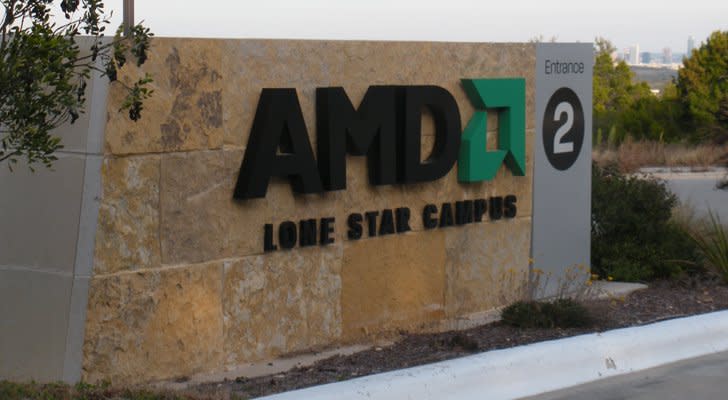Google’s Gaming Platform Is Not a Reason to Buy AMD Stock
Given the 10% gain AMD (NASDAQ:AMD) logged on Tuesday, many investors are optimistic about the latest news. But I don’t personally believe the company’s role in a new streaming-game platform developed by Alphabet (NASDAQ:GOOG, NASDAQ:GOOGL) is a reason to buy AMD stock.

Source: Matthew Rutledge via Flickr Some investors will disagree with me — although most of those investors will tout AMD optimism for any and all reasons. Advanced Micro Devices stock has been terribly rewarding since turning around in 2016. Traders have largely convinced themselves the foreseeable future is going to look a lot like the past.
A closer, critical look at the new video game service from Google, however, reveals AMD’s role is the least important one in a platform that may or may not be a smashing success.
It’s Complicated
Hardcore gamers may understand the implications better than the average non-gamer, but for the rest of us: Even as Microsoft’s (NASDAQ:MSFT) Xbox or Sony (NYSE:SNE) Playstation move toward downloaded games and away from physical discs, their games are played — and processed — on the consoles themselves. Meanwhile, on Google’s Stadia, games will be played entirely from Google’s servers using a high-speed internet connection.
InvestorPlace - Stock Market News, Stock Advice & Trading Tips
AMD’s role in the new service? It handles the heavy-duty graphics processing from the cloud, rather than offloading that work onto a graphics card that would normally be installed on a console.
See, with Stadia, there is no physical console. The cloud is the console, meaning its games can be reasonably played on any device.
It’s actually a rather savvy and gutsy move from Alphabet. Microsoft can create a complete, self-contained gaming experience on an Xbox. Ditto for Sony. Not so with Stadia though. While it can handle most aspects of game-play, Google and AMD are still ultimately relying on the speed and quality of the internet connection its gamer customers subscribe to.
Surprisingly, it’s not been a problem yet. Initial tests of the service’s latency — or the lag between pushing a button on a controller and seeing the result on a screen — suggest Google has figured out how to make the Stadia experience almost as good as that of console game-play. Google, meanwhile, has developed a custom game-controller to further abate potential latency.
There’s a rub for current and would-be owners of AMD stock, however. Of all the major hurdles that Stadia has to clear to work well, Advanced Micro Devices’ is the easiest.
It would also be the easiest piece of the puzzle to replace.
Are Google’s Plans Too Expensive?
That’s not to say AMD could be replaced by a rival like Nvidia (NASDAQ:NVDA) or Intel (NASDAQ:INTC) with just the flip of a switch.
The architecture powering Stadia is based on AMD’s Radeon GPU, but customized to meet Google’s specific needs. Each card is capable of handling up to 10.7 teraflops of data at a time, handily topping the graphics-processing loads being handled by even the newest consoles like the PS4 Pro and the Xbox One X.
The end result? Stadia will be able to deliver 4K quality at the 60 frames per second most gamers expect from high-end games. When the time comes, Google promises 8K quality and 120 frames per second.
AMD’s GPU prowess may not matter, however, for a handful of reasons.
One of them is the aforementioned lag, or latency, of an internet connection. Connections as fast as 50 or even 100 megabits per second are quickly becoming the new norm, and the advent of 5G promises even wider access to ultra-high speed connectivity. Still, for streaming gaming, that connection has to be consistent, and free of any glitch.
There’s also the not-so-small matter that to deliver 4K, 1080p 60FPS images that can accept and process constant user input (button-mashing), Google will have to establish 7500 edge-nodes all over the world. And, it appears that to achieve the maximum quality of graphical display, multiple GPUs will be needed per one single player. The company’s gaming data centers will, most likely, ‘share’ graphics cards simultaneously with multiple gamers, but even the best GPUs can only do so much at one time.
That makes the hardware and node-management needed to make Stadia work an expensive proposition, which in turn could make Stadia an expensive service to utilize.
To that end, there comes a point when gamers stop needing ‘more’ visual realism to enjoy a game to its fullest. Prepping for an 8K, 120 FPS future is arguably an expensive overkill. So if they’re looking to cut costs, Google might opt for a cheaper alternative to AMD’s superior GPUs.
And of course there’s the X-factor: Can Google get developers on board with yet another platform that facilitates even more competition?
Bottom Line for AMD Stock
Buy AMD stock, or don’t buy it. There’s a bearish and bullish case to be made. Neither of those cases, however, are significantly altered by the advent of Stadia.
And, even to the extent Stadia does gain traction when launched, a couple of pros point out the prospect should have already been built into the price of AMD stock.
“We don’t know why AMD was up so much as most analysts knew of this win already,” said Susquehanna analyst Chris Rolland, while RBC’s Mitch Steves explained “We are surprised by the stock price move as we believed this was a well known win.”
As of this writing, James Brumley did not hold a position in any of the aforementioned securities. You can learn more about James at his site, jamesbrumley.com, or follow him on Twitter, at @jbrumley.
More From InvestorPlace
The post Google’s Gaming Platform Is Not a Reason to Buy AMD Stock appeared first on InvestorPlace.

